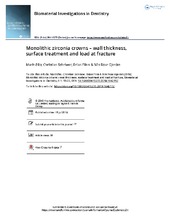Monolithic zirconia crowns – wall thickness, surface treatment and load at fracture
Peer reviewed, Journal article
Published version

Åpne
Permanent lenke
https://hdl.handle.net/1956/21616Utgivelsesdato
2019Metadata
Vis full innførselSamlinger
Originalversjon
https://doi.org/10.1080/26415275.2019.1642112Sammendrag
Purpose: The aim of this study was to evaluate the effect of wall thickness on load at fracture of monolithic zirconia dental crowns after aging. Materials and Methods: Seventy translucent monolithic zirconia crowns (DD Bio ZX2, Dental Direkt GmbH) were produced to fit a second upper premolar preparation with a circumferential shallow chamfer. Thirty crowns had a minimum wall thickness of 0.4 mm and 40 had 0.8 mm. TwentyAQ4 of the thick-walled crowns were glazed. The remaining crowns were polished. Ten crowns from each group functioned as controls, while the remaining were subjected to an aging procedure of alternation between dynamic loading and autoclaving. The surviving crowns were assessed for margin damages and surface wear before beeing subjected to quasi-static loading until fracture. All fractures were analyzed by fractographic methods. Results: There were statistically significant differences among the test groups concerning the effects of aging and surface wear. All thick-walled and eight of the thin-walled crowns survived the aging procedure. All fracture origins both from dynamic and quasi-static loading were located in the cervical margin with crack propagation corresponding to cervical hoop stress as observed in clinical failures. Conclusions: Thin-walled translucent monolithic zirconia crowns were more affected by the aging procedure than thick-walled crowns.
